

|
| Reviews
and Publicity |
|
|
The
Boston Globe Magazine
March 4, 2001
"Celluloid
Dreams" article
|
|
|
dotCULT.com
- review
"Being an independent film my expectations for it were pretty
low, however it’s safe to say that they were greatly exceeded.
From what I saw, Eric definitely has some talent; talent that
needs to be encouraged."
|
|
|
Slapass.net
- review
"The movie was very comical, very effective for its low budget,
something that many people can relate to, and a great way to keep
your hand from stroking your cock for at least an hour and a half!"
|
|
|
Siklink.com
- review
"This movie is the second movie since the Blair Witch
that again proves a great story line and NOT a massive budget
is the key to success."
|
|
|
Ajayonline.com
- review
"What's really refreshing about this movie, though, is it's
subtle sensitivity to absurd people and quirks... nuff said! Download
it and watch it!"
|
|
|
2400bps.com
- review
"there are uncountable gem scenes within the whole work that
are among the most funny ive ever had presented to me."
|
|
|
Ratatak.com
- review
"This
is a very funny movie and it relates very very well. The last
time I laughed this much was when I forgot to take my medication."
|
|
|
Guy
Flick/Girl Flick
- review
A Girl's View: "Just goes to show a huge Hollywood
budget is not a prerequisite for an entertaining film."
A Guy's View: "I don't think there was a solid minute
in the whole film when I didn't laugh."
|
|
|
The
Wire Factory
- review
"The film itself is a very funny and true to life story
that could be compared to anyone's search for love"
|
|
|
Tuesday
Night Movie Club - review
"This
is a very funny film. The great majority of comedies that emerged
in 2001 weren't anywhere near as amusing as this one."
|
Boston
Globe Magazine - March 4, 2001
Goto: Dick
Dahl's early draft version (first person view)
|
 Eric
Bickernicks wanted a legacy. So he made a little film. And he's
not the only one: Boston's indie scene is popping. Eric
Bickernicks wanted a legacy. So he made a little film. And he's
not the only one: Boston's indie scene is popping.
By DICK
DAHL
|
February 13, 2000.
Today is the day when Eric Bickernicks's dream stops being just
a dream.
He's the athletically built guy who's looking through the viewfinder
of a super 16mm movie camera at two men seated at a desk. Geoff
Briggs and John MacLeod are actors, and the donated office space
In the Cummings Center office complex in Beverly is serving
on this blustery Sunday as a movie set. Bickernicks glances
at a black-and-white monitor showing the actors' images in the
precise dimensions of the film that Bickernicks will soon begin
to shoot. He's added a video device called a tap to the new
movie camera as a cost-cutting tool. Using the tap, a VCR, and
the monitor, he and the actors can run through scenes and iron
out visual kinks before using actual film, which costs $30 per
minute of running time.
Bickernicks is the director, producer, screenwriter, cinematographer,
and casting director of a movie he's calling alt.sex, and today
is the first day of shooting.
Despite its name, alt.sex Is not porn. It's a light, somewhat
lowbrow comedy. Think Woody Allen meets the Farrelly brothers
(There's Something About Mary). It's also Indie. Very indle.
Like thousands of other movie nuts inspired by such success
stories as The Blair Witch Project, which has generated hundreds
of millions of dollars on an outlay of $40,000, Bickernicks
has decided to dig into his own pockets, and maybe those of
a friend or two, and make his own movie.
Unlike the people who cash in their savings or max out their
credit cards to finance their movies, Bickernicks had a bit
of money available, but not much. The owner of Biksco Media
Services, a small video production company in Marlborough, Bickernicks
has allocated $10,000 to make his movie. This is a low figure,
even by indie standards, but he already owns much of the film
equipment he will need: lights, sound equipment, and, most significantly,
a computerized editing system of the sort that most independent
filmmakers must rent for hundreds of dollars a day. Bickernicks
estimates that if he had had to rent the equipment, the price
tag for alt.sex could have been $40,000 or more.
|
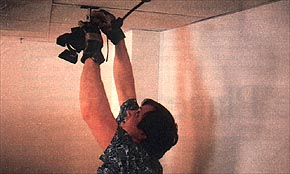 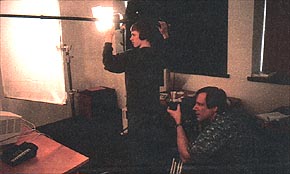 Eric
Bickernicks-the director, screenwriter, cinematographer, and casting
director of alt.sex - adjusts a light before filming a scene in
Allston.
Eric
Bickernicks-the director, screenwriter, cinematographer, and casting
director of alt.sex - adjusts a light before filming a scene in
Allston.
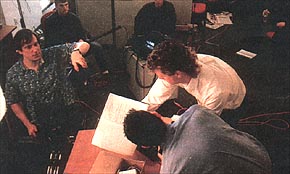 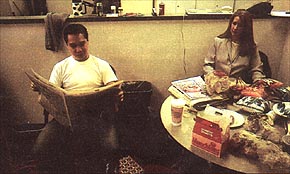
The director discusses the script with actors Phil Rectra (front)
and John Horrigan. Right: Rectra and actress Robin Frank wait
for filming to resume.
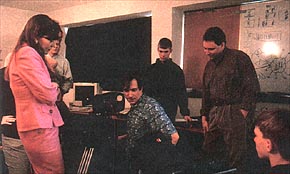
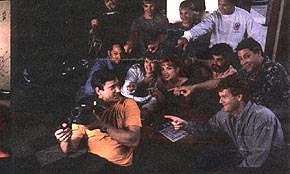
With cast and crew, Bickernicks watches a playback. Right: On
location at the Wonder Bar. Below: Making a sound check and preparing
for action.
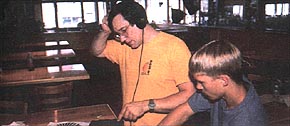
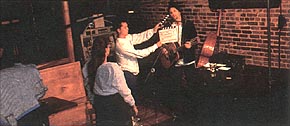
|
|
Bickernicks
entertains no illusions about his movie's chances for success.
The odds that people will actually pay money to see alt.sex and
its cast of unknowns are slim. Although he obviously wants that
to happen, Bickemicks says the real reason he's making the movie
is because when he's an old man, he wants more to show for his
life's work than a stack of corporate training videos.
He's dreamed of this day for a long time.
Now 38, Bickernicks began to act on his mid-life crisis two years
ago by studying the craft of screenwriting and beginning the script,
for alt.sex, a simple tale of an average Joe who loses his girlfriend,
Irene, and seeks, through the well-intentioned assistance of his
pals, to find true love - or at least a date - in the hellish
world of middle aged matchmaking. (The title refers to several
computer-related sub themes dealing with Internet chat rooms and
a running bit about pom sites popping up at embarrassing times
on characters' workplace computer screens.) By late 1999, Bickernicks
had put out a casting call and was deluged by actors willing to
work for nothing.
Briggs, 40, and MacLeod, 38, are ready. Bickernicks's rookie sound
crew, 17-year-old twins Brandon and Emery Bond, who are friends
of MacLeod, are also ready. Bickernicks gave them their first
lesson in the craft of boom-mike holding and tape-console operation
just this morning. Bickernicks's gir1friend, 46-year old Therese
Chase, who has a small role in the movie but is here today to
help out, holds the slate, with its diagonally striped black-and-white
arm, in front of Briggs's face.
"Scene 10, roll one, take one," Bickernicks announces.
The sound of film clattering along the camera's sprockets is Chase's
cue. Hearing it, she clacks the arm down.
MacLeod, playing the protagonist, John, slides into an office
chair next to Briggs and speaks his lines: "I just got totally
spammed! My e-mail accounes frozen. Can you check it out?"
Alk.sex is off and running.
Stories like this are not unusual around Boston, home to an increasingly
lively independent film scene. Although it's difficult to come
up with hard numbers, Robin Dawson, director of the Massachusetts
Film Office, estimates that around a dozen feature-length projects
have been shot in the area in the last year. But longtime indie
film booster David Kleiler, head of the group that saved the Coolidge
Comer Cinema in Brookline from commercial developers, estimates
the figure to be more like 20. As a consultant to independent
filmmakers and creator of the Boston Underground Film Festival,
Kleiler figures he knows the indie film scene pretty well, but
each year when it's time for the festival, he says, "there
are always two or three films that get made that I had no idea
about."
The emergence of an independent-film industry in the United States
is a relatively recent phenomenon. Since the beginning of commercial
film, Hollywood studios have nearly monopolized the movie industry.
But in recent years, things have changed. In 1980, former Bostonian
John Sayles turned from fiction writing to film, creating a movie
on his own, The Return of the Secaucus Seven, for $60,000, one
of the first successful indies.
Today, a separate national indie-film industry, complete with
indie-film houses like the Kendall Square Cinema in Cambridge,
exists. In Boston, there are indie filmmakers, indie producers,
indie film classes and support organizations. But there really
isn't a Boston indie-film industry, in the truest sense of the
word. "The reason," Kleiler says, "is because independent
films are not getting financing here."
Anne Marie Stein, director of the Boston Film and Video Foundation,
agrees: "Boston has traditionally been more of a documentary
town; narrative films are catching up, but there's not much of
a distribution network for either."
Rob Patton-Spruell, who maxed out his credit cards to finance
his first movie, Squeeze, in 1995, sees the same problem. Patton-Spruell,
after an unhappy sojourn in Hollywood, returned to his Roxbury
home in 1999 and set up shop to help other indie filmmakers get
their projects done. Last year, he opened The Film Shack, a production
facility for small-budget indie movies. Filmmakers can rent equipment
and take classes from a group called City Scope, which rents space
at the Film Shack from PattonSpruell. He says he will also be
looking for projects to produce. His goal, PattonSpruell says,
is to "blaze a trail" for small, indie filmmakers who
face great odds in getting their work funded and distributed.
Still, if the money and distribution are lacking, the ranks of
noteworthy indie producers - the critical deal arrangers - have
grown. One of the preeminent producers in Massachusetts, Sarah
Green, has a long standing working relationship with Sayles and
Newton playwright and filmmaker David Mamet. She produced Mamet's
recent film, State and Main. According to Green, the first real
Boston indie narrative film to get any kind of distribution was
Mamet's Oleanna, which she also produced, in 1994.
That same year, two novice filmmakers, Brad Anderson and Lyn Vaus,
had assembled $65,000 from various personal sources to shoot a
movie called The Darien Gap, about a young man who trades his
apartment for a video camera to make a documentary about his friends.
The movie was shown at the 1996 Sundance Film Festival, where
the Village Voice proclaimed it "far and away the best"
film at Sundance that year. Nevertheless, other than showings
on the Sundance Channel and the Independent Film Channel, The
Darien Gap has never been commercially distributed.
It did, however, launch the careers of the movie's creators. In
1998, their second movie, Next Stop Wonderland, was a Sundance
smash. The movie, a critical and commercial success, came out
at about the same time as Matt Damon and Ben Affleck's Boston-based
hit Good Will Hunting, and suddenly Boston was on the filmmaking
map.
By that time, another indie-production house, Scout Production,
had set up shop in, Boston. The creation of three Hollywood film-production
veterans, Dorothy Aufiero, David Collins, and Michael Williams,
all of whom moved to Boston in 1995, Scout occupies a large space
in a former factory building in Allston. The company has produced
a variety of well known indie ventures, including quirky documentarian
Errol Morris's 1999 movie, Mr. Death.
And although the bigger-name projects like Session 9, Brad Anderson's
newest venture, attract investor dollars, there are always the
little ones like alt.sex that are self-financed passions of the
heart. But without a big reputation to attract investors, where
do aspiring independent filmmakers go for money?
"It takes incredible resourcefulness to make a movie,"
says Stein of the Boston Film and Video Foundation. "People
do the fund-raising in any number of ways."
Some do it themselves. Alice Cox, a 1995 graduate of the Massachusetts
Institute of Technology, decided in 1999 to cash in the stock
options she had received from her job as a software engineer and
try her hand at filmmaking. She wrote a script for a movie called
Metal, assembled actors, and shot the film over three weeks last
spring for around $60,000. She unveiled it at the Boston Film
and Video Foundation last November. The movie blends a quasi-sci-fi
alien cloning story with a paean to Allston. It's atmospheric,
moody, weird. It's very Indie.
The problem the 27 year-old Cox faces is that the liquidated stock
options have ran out. In order to get the movie accepted by any
festival committees, she estimates that she has to spend about
$30,000 to turn her 16mm negative into a print. She doesn't know
where the money will come from. At the moment, she says, her primary
focus is on her next script, Contrary Souls, which is based partially
on her career as a software engineer.
"It's like Dilbert, " she says, referring to the comic
strip, "but disturbing."
|

Note from Eric:
If you attempted to read this story in the Boston Globe magazine,
you would've noticed all these annoying ads strewn all over it's
pages. I've included some to more acurately mimic the experience
of reading this piece in the newspaper. |
AUGUST
5. The bright lights, the movie camera, and an actress in a strange
outfit have attracted a small crowd on the sidewalk outside The
Wonder Bar, an Allston jazz club by night but today serving as
the set for the alt.sex restaurant scenes. Deirdre Williams, in
real life the afternoon traffic reporter on Boston radio station
WBMX "Mix 98.5," plays the part of The Computer Date.
She is wearing a dress and a hat made out of fake dollar bills.
John has paid $900 to a dating service. Distracted by the high
cost of the service - as well as by a fight in the street - John
fails to pay adequate attention to what his date is saying. Computer
Date leaves in a huff. The scene goes well, and when the film
stops running, everyone howls with delight.
Spirits are high. Although the crew shot a few scenes here three
weeks ago, today's activity is the beginning of the first weekend
long shoot since mid-April. Bickemicks had suspended the project
because the used movie camera, which he'd bought off the Internet
auction site eBay for a mere $4,800, or about one-fourth the price
of a new one, had a slight problem: It often didn't focus properly.
Some of the North Shore office shots would have to be redone.
He sent the camera to be repaired, and in the meantime took on
some more corporate video work.
During the hiatus, the casts group e-mails became increasingly
forlorn. Contrary to the perception that actors are egomaniacs,
the alt.sexers had become a happy family. Although all have acting
experience, for most, alt.sex is their first film. They all know
their chances of making any money are slim, though Bickernicks
keeps track of everyone's time, so that if someday someone should
buy alt.sex, he will be able to divvy up the money. But the excitement
and camaraderie seem to be compensation in themselves.
"I thought that [acting in alt.sex] would be one of those
things where I'd say, 'Oh, this is OK,"' says 32 year-old
actress and Attleboro High School teacher Robin Frank, who plays
a shy office worker. "I didn't know that I'd be making some
of the coolest friends I have. I really miss everybody."
Because it's now the middle of summer and most everyone's skin
has darkened, and because the "dlays" of the story being
shot this weekend must correspond to those shot months ago, some
of the actors have turned to a laptop computer to help them match
their makeup and wardrobe from previous shots. They call up the
alt.sex Web site, www.altsexmovie .com, and inspect photos that
Bickernicks and a couple of the actors have placed on the site.
The photos accompany Bickernicks's "director's journal."
His hero, it should be noted, is filmmaker Robert Rodriguez, who
wrote a book, Rebel Without a Clue detailing how he made his first
movie, the critically acclaimed 1993 film El Mariachi, for $7,000.
To many aspiring filmmakers like Bickernicks, the book is a bible.
In keeping a record of his experiences, he's following Rodriguez's
lead.
Most of the action at this weekend's Wonder Bar shoot revolves
around-John and his inept efforts at meeting women. After the
Computer Date scene, the script calls for our hero to meet someone
he's contacted through the personal ads. It turns out to be a
rather masculine-looking person wearing a dress. The actor is
Tammy Twotone, a real-life transvestite. Needless to say, things
go badly.
When that scene is done, MacLeod has yet another one to test his
abilities to bumble in front of the camera. His pals, played by
Briggs, John Horrigan, and Phil Rectra, goad him into approaching
the pretty but aloof redhead sitting alone at another table. That
character, Mystery Girl, is played by Cara O'Shea, a New York
actress.
MacLeod approaches her as she sits reading Memoirs of a Geisha.
He proceeds to make clumsy attempts at conversation as she glares
at him.
"Um, that's a nice book."
"Are you a real redhead?"
"I can lick my eyebrows."
He's playing with a spoon, fumbles it, sends it flying
"My friends wonder if you've been here before."
A phone behind the bar rings.
"Cut!"
Bickernicks looks down from the camera, shakes his head. The day
is growing long, and the interruption is not the first. Unwanted
noises - a siren, a squeaking chair, people talking loudly, the
air conditioner kicking in - have halted several shots.
They try again. This time, they succeed.
It's 4:30 p.m., time for the bar to prepare for the evening's
business. With help from the Bond twins and a couple of actors,
Bickernicks schleps equipment outside and piles it into his car.
It was a good day. He's now shot 20 rolls of film, one-third of
his projected total.
OCTOBER 7. The sun, sinking toward a bank of dark clouds, is already
losing candlepower. In the middle of a modest beach next to Edgewater
Road in Quincy, a clown, his face painted white and blue, his
nose a red ball, casts anxious glances westward. The clown is
Bickernicks, and today he gets himself into his own movie.
After today, only a few more days of shooting will remain. Then
a winter of editing. By spring, or maybe summer, a finished 35mm
print should be ready for the festival circuit. And then, who
knows? Maybe the movie's flavor of oddball comedy will catch a
festival committee's eye and become the surprise hit of Sundance
2002.
At the moment, however, the light is rapidly dissipating.
Today's scenes all deal with John's efforts to win back the cold
heart of his girIfriend, Irene, played by Boston stand-up comic
Lauren Verge.
At the movie's start, they are a couple in the death throes of
an office romance. She dumps him for another colleague who is
a notorious ladies' man. At the same time that John has been exploring
every avenue to get a date, he's also been tying, pathetically,
to win Irene back.
Now, John has arranged a meeting on the beach with Irene, because
his female co-workers have told him that beaches are romantic.
They also have said that balloon-bearing clowns are very romantic.
So he hires one. He also hires a violinist, which explains why
Berklee College of Music graduate Jonah Shue was standing on the
steps of the Quincy Center T station an hour ago. Bickernicks
had placed an ad, posted on a Berklee bulletin board, for a violinist
willing to play schmaltz for no pay in an indie movie. Shue phoned
Bickernicks, said, "Schmaltz? I'm your man," and the
two men came to rapid agreement on the terms: Show up Saturday
with your violin; it'll be fun. After Bickemicks and Therese Chase
pick up the down outfit at a costume-rental store, they swing
by the T station to pick up Shue.
Arriving shortly after noon, Bickernicks, the Bond twins, and
MacLeod and actor friend Dan Bridges, who appeared in the office
shots and is here today just to help out, begin setting up. Even
though his appearance will be the day's final shot, Bickermcks,
dons his down outfit and sits quietly as Chase paints his face.
Once the shooting starts, there must be no interruptions.
Clown on the beach. It doesn't take long for the exciting news
to course along the adolescent grass roots to the neighborhood
next to the beach. Soon, small heads are popping up here and there
along the sea wall. And soon, Chase takes on a job she hadn't
anticipated: crowd control. The children want to meet the down.
But the down is very, very busy.
The clown is racing the sun. The scene, at water's edge, calls
for John and Irene to be bickering. She had not anticipated that,
in agreeing to meet John, she would have to deal with these huge
overtures. Shue, the violinist, is following close behind, playing
"La Vie en Rose," which annoys Irene. She screams at
him to get lost. The sky is mostly black clouds now, but there
are breaks between them. Bickernicks holds his camera and waits
for Bridges, holding a light meter and reading its numbers, to
signal an opening.
They shoot the scene several times during these celestial reprieves.
Each is pure Fellini with, perhaps, shades of Bergman: a clown
Ranked by identical twins, walking backward in front of an arguing,
gesticulating couple who are trailed by a violinist in a dark
suit, all bathed in deep orange-red light.
 Finally,
the time has come for Bickernicks's entry into his own film. There's
no sunlight left, no gaps in the clouds. But the lab can correct
for poor light, so the crew presses on. The clown pulls up in
front of John and Irene, breathless from a supposedly long run.
To the exasperated Irene, this is the last straw, and she walks
off. Whereupon John departs, frustrated, in the other direction,
and the clown is standing there with the balloons in his hand.
The script calls for him to shrug and release the helium filled
balloons. Because he has no backup balloons, this scene must be
shot right. A group of small boys whom Chase is holding back have
plans of their own, though. When Bickernicks releases the balloons,
they race into the scene, trying - without luck - to snatch the
balloons out of the air. Bridges, operating the stationary camera,
says he thinks the shot is salvageable. Finally,
the time has come for Bickernicks's entry into his own film. There's
no sunlight left, no gaps in the clouds. But the lab can correct
for poor light, so the crew presses on. The clown pulls up in
front of John and Irene, breathless from a supposedly long run.
To the exasperated Irene, this is the last straw, and she walks
off. Whereupon John departs, frustrated, in the other direction,
and the clown is standing there with the balloons in his hand.
The script calls for him to shrug and release the helium filled
balloons. Because he has no backup balloons, this scene must be
shot right. A group of small boys whom Chase is holding back have
plans of their own, though. When Bickernicks releases the balloons,
they race into the scene, trying - without luck - to snatch the
balloons out of the air. Bridges, operating the stationary camera,
says he thinks the shot is salvageable.
Bickernicks hopes so, but he's not sure. But he's grumpy now,
and the children no longer want to meet the clown.
The following week, Bickernicks sits in front of a Macintosh computer,
tying together images and sound and blending them into the illusion
that is film. After every weekends shoots, he sends the film to
a finishing house, which processes it and returns a video of the
footage. He edits the video on his computer. Pulling up different
takes of the same scene, he cuts back and forth and produces a
sequence that looks real.
The Quincy beach shots aren't back yet, but he does have the sequences
filmed earlier at Sophia's, a Boston nightclub where he shot the
movie's wildest footage. It was the first time he had held his
camera while filming. It was also the first time he had shot in
a crowd. He had put out a call for extras for each of the three
days that he shot in the nightclub's basement bar, and each day
12 to 15 youngish, good-looking men and women in their favorite
nightclubbing clothes showed up in hopes that maybe someday they
would see themselves on the big screen.
Much of this footage is improvised: Bickernicks just wound his
way through the crowd with the camera on his shoulder without
any sound running, his actors hamming it up with dance moves and
come-on lines with the women. The swirl of images has Bickernicks
in editing heaven.
With the shooting now nearly finished, Bickernicks is turning
his attention to the future. "My dream objective is to find
an agent who has all the connections who'll say: 'Great! Brilliant!
I'm going to take it right to Miramax and tell them they've got
to buy your film.'"
Plan B is to cut a 35mm negative of the movie for purposes of
having an actual film for the festival circuit~ where, he hopes,
his movie would create a buzz and get noticed by film distributors.
That might set him back another $18,000. Another option, he says,
is going straight to video. The Independent Film Channel, for
one, buys indie products that never make it to movie theaters.
And then, he says, there's the option of "four walling"
- renting a theater for one showing of his film, typically dividing
the proceeds with the theater owner. He tells a story about four-walling:
"Years ago, I did this thing called The Can, shot on super
8. I didn't shoot it; I edited the dam thing. We went to the Brattle
[repertory film theater in Cambridge] and used a video projector.
It was all on video. We got a good write-up in The Boston Phoenix
from some guy who said this is a wacky, independent thing, and
it's gonna be at the Brattle this weekend. We sold out the Brattle.
One show. Three or four people got up and left because they didn't
like it. We had a little party, da da da da."
After that, they ran an ad in the indie magazine Film Threat and
sold 50 tapes of The Can.
The experience, he says, taught him a lesson: If you're resourceful
enough to make a film for very little, you should be resourceful
enough to get it seen. And now with the brave new world of the
Internet, Bickernicks thinks the challenge of getting your work
seen - even if there's no money to be made - will be all the easier.
There are indie-film sites now that publicize works deemed worthy.
Bickernicks envisions sending free copies of alt.sex to them in
hopes that they will recommend clicking on his own Web site, which
has film clips and order forms.
The "absolute worst case scenario" for alt.sex, Bickernicks
says, is to distribute it for free on the Internet. Formats already
exist allowing the compression of entire movies into downloadable
file space. A small clique of people on the Internet has begun
trading movies in this format, he says.
Of course, what he really wants is people to watch his movie the
old-fashioned way: Sitting together in a dark theater as clean,
pure film whirs past a projector bulb.
"I'm all set, literally, to get into a van with my one print
of film and take it to each city and do my own fourwalling - even
if the film festivals don't take me. I'm planning on giving out
a money-back guarantee to people if they don't like my personal,
handmade movie."
Bickernicks believes in his little film. He thinks he's got a
good script, a good and spirited cast, and that his technical
prowess will make it a wacky and watchable entertainment. But
he doesn't know for sure. One thing he does know is that when
he's 85 years old, he will have something more than some training
videos to show for his life's work. He also knows that he will
have a story to tell.
|
Main
Page | alt.sex Journal
| Tech Info | Publicity
| Film Clips | Indie
Links
Music | Message
Board |
|
 |







